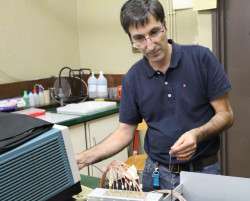What if neutron scattering uses the same type of detectors used to look into space?

An EU-funded SINE2020 team is working on developing Resistive Plate Chambers for neutron detectors to help improve experiments for scientists across Europe.
Resistive plate chambers (RPCs) are widely used for large area detectors, as for instance, in High Energy Physics to study the nature of the particles that constitute matter or in Astroparticle physics to observe cosmic rays. Due to their simple structure these detectors are not expensive. Despite the simplicity, they provide very good spatial resolution and very fast timing. Researchers from LIP Coimbra, Portugal, are investigating the use of RPCs for neutron scattering detectors in the framework of the SINE2020 Detectors WP. Improving neutron experiments will help advancing knowledge in fields as varied as e.g. health, energy, arts, and agriculture.
I talked with Luís Margato who told me that, RPCs don't seem to have ever been used for neutron scattering. So why does his team think they could be a good solution?
- Its built-in layered configuration is well suited for multi-layer detector architectures, needed to ensure high detection efficiency.
- They are essentially discharging-free and robust detectors and thus there is no need for "baby-sitting" or continuous monitoring.
- RPCs have a very simple structure: two plates at least one of them made of a resistive material (e.g. glass or ceramic) and a gas-gap.
Looking inside the detector
Detectors are used to identify with high precision the localisation of neutrons interaction during an experiment. The team will investigate what happens when 10B-coated RPCs are used for neutron detection and how they perform. They will work on the construction of position-sensitive 10B4C coated RPCs with a multi-layer configuration. The 10B4C coatings for the RPCs have been produced by the European Spallation Source Detector Coatings Workshop. Detector prototypes evaluation with thermal neutrons will be performed in a beam line at the FRM II neutron source.
Step-by-step towards high detector efficiency
The team started by a simple RPC configuration and thus designed two prototypes to be tested, one of them with a 10B4C-coating and another one without. Earlier results showed that the detection efficiency of the RPC coated with 10B4C was just as high as expected. The experimental results showed an extended plateau as a function of high-voltage, in a region (see graph) where RPCs show low sensitivity to minimum ionising particles, which means the detector is sensitive to neutrons while the sensitivity to gamma rays is expected to remain very low. A spatial resolution bellow 1mm FWHM was demonstrated in these preliminary tests.
After the initial good results, the team joined the SINE2020 project and started to investigate one of the main parameters of RPCs. They wanted to understand how the gas gap width influences the RPC response. They designed two prototypes and tested them at the FRM II Neutron Source, Germany, in July 2016. The resolution improved considerably, with results showing a 2D position resolution of at least 0,5mm FWHM for both coordinates.
At the moment the team is characterising the gamma sensitivity of the two RPCs tested at FRM II with 22Na and 60Co gamma sources at LIP; they are examining the waveforms of the Fast and Slow component of the induced signals, with the intention to check the possibility of pulse shape discrimination to reject gamma rays and background events; and they are designing and building a stack of double-gap RPCs with narrow gas-gap widths.
Benefits of taking part of SINE2020
Taking part of SINE2020 has important advantages. Funding was essential for the team to pursue their R&D activities on innovative detector technologies for thermal neutrons. Continuous access to beam-lines on neutron facilities to perform the evaluation of detector prototypes shortens the time required for developments and new ideas to be realised.
The possibility of exchanging knowledge and experiences with the detector expert community of the European-leading neutron facilities is fundamental for the team to drive its know-how towards the detector requirements.
Provided by CORDIS



















